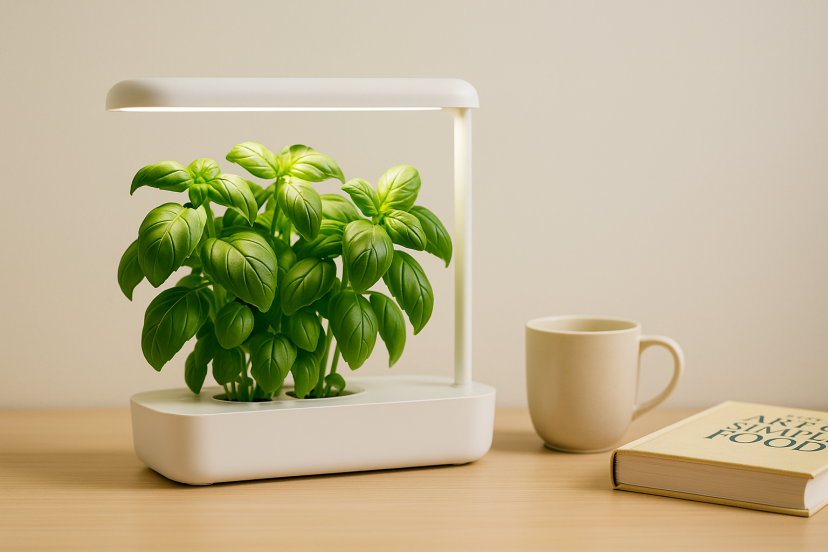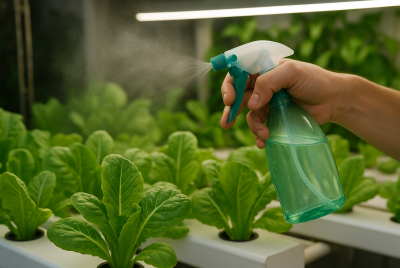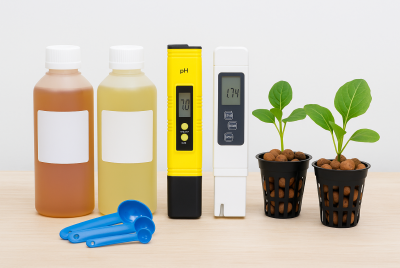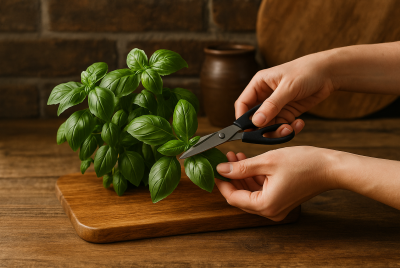How to Grow Fresh Hydroponic Basil Indoors Easily (Step-by-Step)
We may earn a commission for purchases made using our links. Please see our disclosure for more details.
Hydroponic basil is a great idea if you enjoy fresh herbs but hate having to wait for them to grow. This approach grows basil indoors, faster, cleaner, and year-round, using nutrient-rich water and LED light instead of soil or sunlight. This complete guide will show you exactly how to cultivate fragrant, rich basil in your kitchen, no matter your level of experience as a home gardener or your desire to upgrade your setup.
What Is Hydroponic Basil?
Hydroponic basil is basically basil grown in water rather than in the soil. Instead of soil, the roots take nutrition straight from a water-based solution that contains all of the minerals and elements the plant requires to grow.
This strategy results in an optimal growing environment that is cleaner, faster, and considerably more efficient. Because nutrients are delivered directly to the roots, basil spends less time hunting for food and more time creating robust, fragrant leaves.
A 2024 comparative study published in PlantArc found that basil grown hydroponically produced 26.46% more biomass and had a stronger aroma than its soil-grown counterpart. That means more flavor, more yield, and less waiting.
Why Grow Basil Hydroponically?
If you enjoy growing plants or cooking with fresh herbs, hydroponic basil is a game-changer. This is why it’s worth it to try:
1. Year-Round Harvests
Unlike outdoor gardens, hydroponics isn’t limited by weather. With controlled light and temperature, you can enjoy basil in summer, winter, and every season in between.
2. Faster Growth
Hydroponic systems deliver nutrients directly to the root zone, which speeds up growth by up to 40%. That means your basil will be ready to harvest in as little as 25–30 days from germination.
3. Pest-Free Gardening
Because hydroponics eliminates soil, you drastically reduce exposure to pests like aphids, gnats, and fungus. For extra peace of mind, try using natural pest control methods to keep your indoor setup chemical-free.
4. Cleaner and Easier Maintenance
No weeding, no muddy pots, and no messy soil bags.The entire setup remains tidy, organized, and effortless to maintain.
5. Environmentally Friendly
Hydroponic systems use up to 90% less water than traditional gardening. It benefits your home, your savings, and the planet alike.
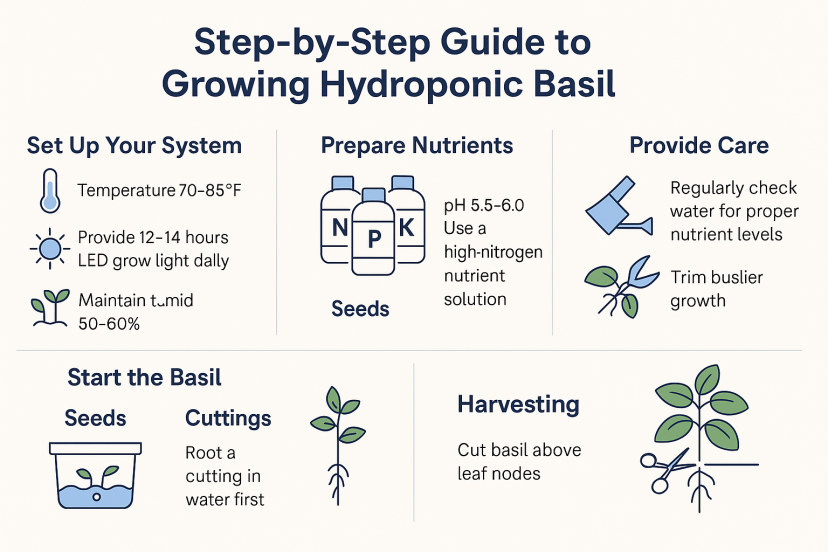
Step-by-Step Guide to Growing Hydroponic Basil
Step 1: Choose Your Hydroponic System
Start by selecting a system that fits your space and skill level:
- Deep Water Culture (DWC): Great for beginners — basil roots hang in a nutrient solution with added oxygen.
- Kratky Method: A simple, pump-free option where roots grow in still water enriched with nutrients.
- Nutrient Film Technique (NFT): A continuous flow of nutrient-rich water ideal for larger yields.
- Wick System: Uses a wick to pull nutrients to the roots — low maintenance and silent.
- Aeroponics: Mists roots instead of submerging them for rapid growth (best for experienced growers).
For most home gardeners, the DWC or Kratky system is the easiest place to start.
Step 2: Prepare the Growing Environment
Hydroponic basil loves warmth, light, and stable conditions.
- Keep temperatures between 70–85°F (21–29°C).
- Provide 12–14 hours of LED or fluorescent light daily.
- Maintain humidity around 50–60%.
- Use a small fan to keep air circulating and prevent mold.
If your space lacks natural sunlight, a compact grow light stand can easily replicate outdoor conditions.
Step 3: Mix Your Nutrient Solution
Basil thrives in slightly acidic water with a pH between 5.5 and 6.0.
Use a hydroponic nutrient mix formulated for leafy greens and herbs. It should include:
- Nitrogen (N): Encourages leafy growth
- Phosphorus (P): Promotes strong roots
- Potassium (K): Improves plant health and resilience
- Calcium & Magnesium: Enhance flavor and leaf structure
Test the solution regularly using a pH and TDS meter to maintain the ideal nutrient balance.
Step 4: Start from Seeds or Cuttings
You can grow hydroponic basil in two easy ways:
From Seeds:
- Place seeds in rockwool cubes or peat plugs.
Keep moist and under indirect light until they sprout (5–10 days). - Once seedlings develop 3–4 leaves, transfer them into your hydroponic system.
From Cuttings:
- Snip a 4-inch stem just below a leaf node from a healthy basil plant.
- Remove lower leaves and place the cutting in a cup of water.
- When roots reach 2–3 inches, move it into your hydroponic setup.
Cuttings grow faster and keep the same flavor and aroma profile as the parent plant.
Step 5: Maintain and Monitor Daily
Hydroponic basil grows quickly with consistent care:
- Check water levels daily to keep roots submerged but not drowning.
- Top up nutrients every few days as plants absorb minerals.
- Replace the entire solution weekly to prevent salt buildup.
- Inspect leaves for yellowing or spots — signs of pH or nutrient issues.
- Trim regularly once plants reach 6 inches tall to encourage bushier growth.
A well-maintained plant can thrive for 3–6 months with continuous harvesting.
Recommended Products
Here are some highly rated, beginner-friendly tools to make your hydroponic basil setup effortless:
| Product | Key Benefit | Ideal For |
| AeroGarden Harvest Hydroponic Garden | Plug-and-play indoor hydroponic system with LED grow lights | Beginners |
| General Hydroponics Flora Series Nutrients | Complete nutrient trio for balanced growth and stronger aroma | Intermediate growers |
| VIVOSUN Digital pH & TDS Meter Combo | Ensures accurate nutrient balance and water quality | Every gardener |
| Grodan Rockwool Starter Cubes | Perfect for seed germination and easy transplanting | Seed starters |
| LED Adjustable Light Stand | Full-spectrum lighting that supports all growth stages | Indoor setups |
These tools simplify setup, maintenance, and monitoring — allowing you to focus on what matters most: watching your basil thrive.
Common Problems and How to Fix Them
Even the best hydroponic systems face occasional hiccups. Here’s how to troubleshoot quickly:
Yellow Leaves
Usually caused by nutrient imbalance or low nitrogen.
Fix: Adjust your nutrient mix and check pH.
Root Rot
Happens when oxygen levels drop or water becomes stagnant.
Fix: Add an air stone or change the nutrient solution more often.
Algae Growth
Algae often appear when the nutrient solution is exposed to light.
Fix: Use opaque containers and keep your setup shaded from direct sunlight.
Pests Indoors
Though rare, aphids or gnats can still appear.
Fix: Use organic, non-toxic sprays like neem oil or learn more about natural pest control options to prevent infestations.
Harvesting Hydroponic Basil
Harvesting isn’t just about cutting — it’s about stimulating continuous growth. Once your basil reaches about 6–8 inches, start snipping leaves from the top.
Always cut just above a leaf node (the point where two leaves meet the stem). This encourages the plant to grow two new branches in its place.
With proper trimming and feeding, hydroponic basil can last up to six months before needing replacement.
As a general guideline, avoid cutting more than one-third of the plant during any harvest. Basil regrows quickly, but overharvesting can stress it.
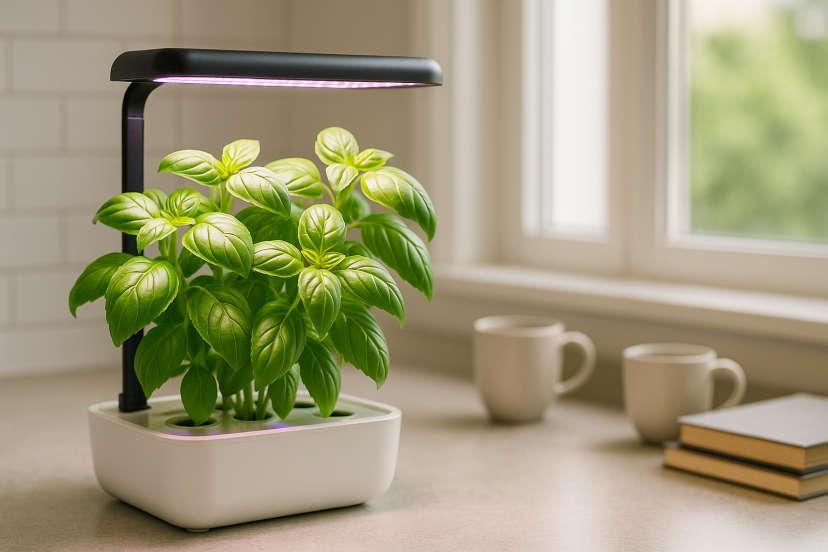
Advantages of Growing Hydroponic Basil
Beyond convenience, hydroponic basil holds some impressive scientific credibility.
A 2025 study published in the Journal of Young Pharmacists revealed that hydroponic basil not only produced higher yields but also demonstrated greater anxiolytic (anti-anxiety) properties due to increased concentrations of active phytochemicals.
Another experiment by PlantArc emphasized improved flavor, texture, and uniform growth in hydroponic conditions — proving that technology and nature can indeed coexist beautifully.
These findings highlight why hydroponic basil isn’t just a modern hobby — it’s the future of sustainable food production.
Tips for Flavorful, Long-Lasting Basil
- Use filtered or distilled water: Tap water may contain chlorine that harms roots.
- Prune regularly: Frequent trimming keeps your basil dense and aromatic.
- Avoid overcrowding: Give each plant at least 6 inches of space.
- Watch your lighting schedule: Too much light can cause leaf curling; too little makes stems leggy.
- Keep it clean: Wipe down trays, lights, and surfaces to prevent algae and bacteria.
Follow these, and you’ll always have fresh, vibrant basil ready for your favorite recipes — from caprese salads to homemade pesto.
Conclusion
Growing hydroponic basil is one of the simplest ways to enjoy fresh herbs anytime, anywhere. With a bit of light, clean water, and the right nutrients, you can harvest vibrant basil leaves straight from your kitchen—even in the middle of winter. It’s efficient, eco-friendly, and incredibly rewarding. Once you taste that homegrown freshness, you’ll never go back to store-bought herbs again.
FAQs
1. Does basil grow well hydroponically?
Absolutely. Basil thrives in hydroponic environments due to the direct access to nutrients and consistent conditions. It often grows faster and fuller than in soil.
2. Can you grow basil in water permanently?
Yes, as long as you use nutrient-enriched water and proper aeration. Plain water alone won’t sustain it long-term, but a hydroponic solution will.
3. How do you keep hydroponic basil alive?
Keep the pH between 5.5 and 6.0, ensure 12–14 hours of light daily, refresh nutrients weekly, and trim regularly to promote bushy growth.
4. How long will hydroponic basil last?
Hydroponic basil typically lasts 3–6 months, depending on how often it’s pruned and maintained. Continuous harvesting keeps it producing fresh leaves longer.
5. What are three plants that are not recommended for hydroponics?
Root-heavy crops like potatoes, carrots, and onions aren’t suited for hydroponics because they need dense soil structure to develop properly.

